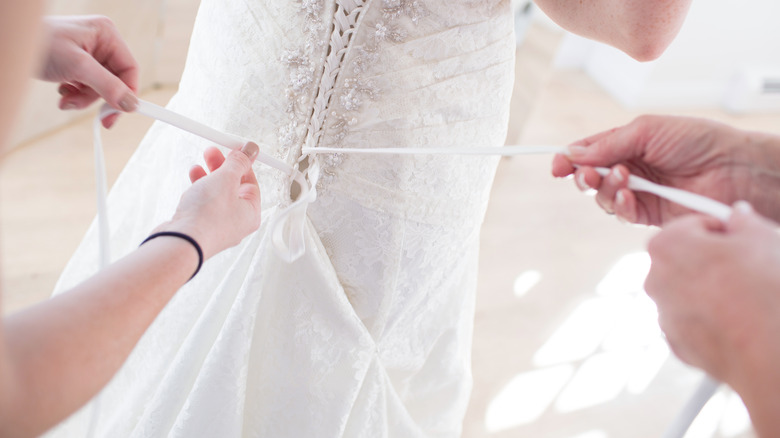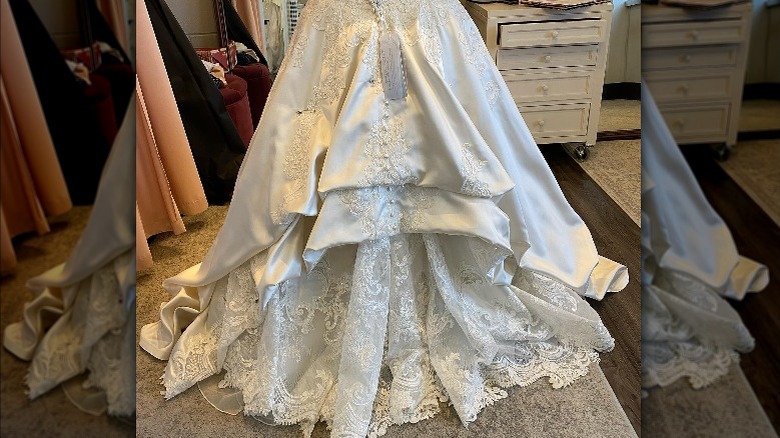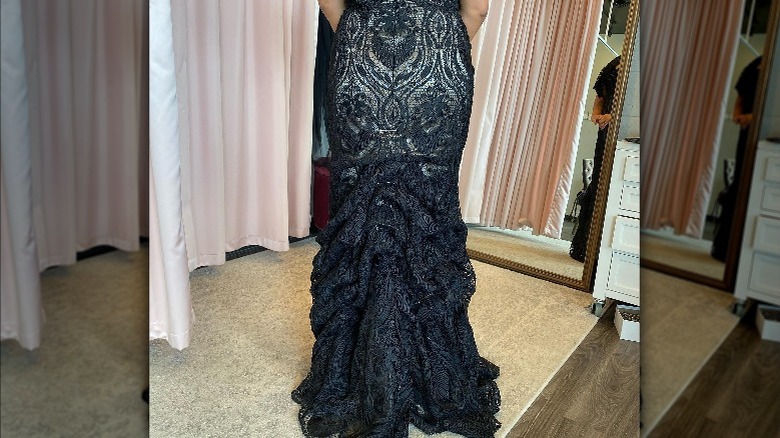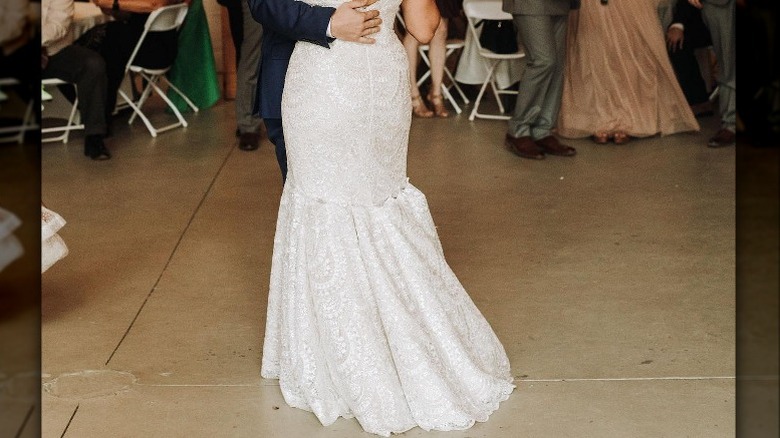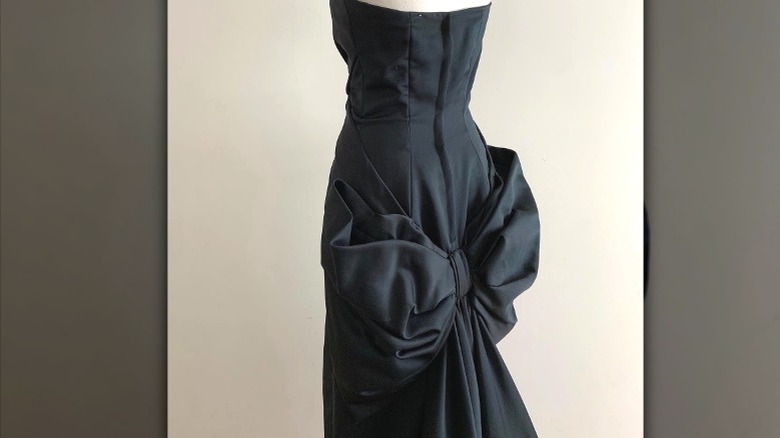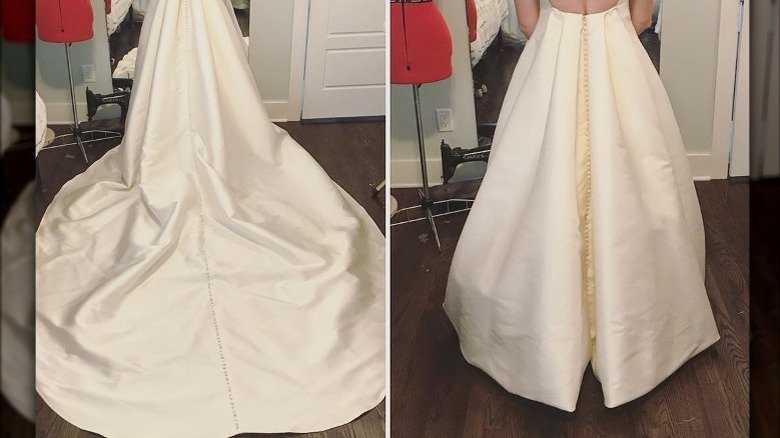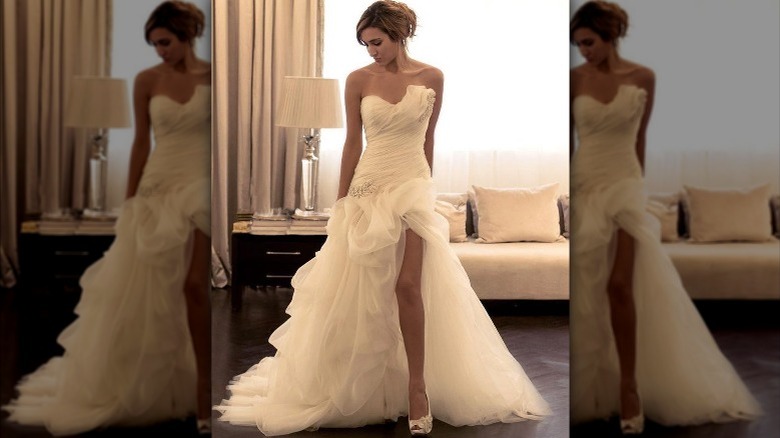Wedding Dress Bustle Types Decoded (& Other Facts To Know)
As you're walking down the aisle, it can be the most elegant trip you'll ever take. Your wedding veil is incredibly flattering, and you're in a gown with a long, flowy train trailing your every step to the altar. Once the ceremony is over, though, and after photos have been taken, your next major event is taking to the dance floor with your new spouse. When you're in a gown with a long, hefty train, dancing can be a tad difficult. Since you're likely head-over-heels in love with both your spouse and your wedding gown, you may feel torn between dancing and removing your beloved dress. This is where every bride is given a fairy godmother in the form of a bustle, where a few sewn bustle points on the dress can turn your long gown fit for a royal wedding into a stunning piece of wearable art as you dance long past midnight. You won't even have to return the glass slippers after the clock strikes twelve!
The purpose of bustles on gowns is to prevent the train's fabric from becoming dirty as the bride wears it beyond the walk down the aisle. Bustles can also allow the bride to move with ease, particularly if the train is so long that it requires someone to hold it. They transition an extraordinary wedding ensemble into functional fashion so that the bride can enjoy both the wedding and reception in a dress suitable for an entire day (and night) of festivities.
American bustles are traditional
Most wedding dresses, or any type of gown with a long train, aren't typically sold with bustles if you purchase them directly from a store or retailer. Instead, part of the fitting and alteration process ahead of your nuptials includes discussion of the type of bustle which will work best for your gown and the aesthetic you're aiming for. Your seamstress will work to meet your needs as you plan your wedding day fashion.
Bustles originated in the Victorian era, and at the time, referred to the high poof-like appearance of dress styles in peak vogue in 1830. Centuries ago, bustles were designed to make the back of gowns look fuller, but today, they've evolved into a way to gather — or bustle — the fabric of long trains behind the dress.
There are numerous types of bustles you can choose from, each of which will give you a distinct style when you're twirling around during your first dance or speaking with guests after the ceremony. Bustles described as traditional or American are synonymous with the straightforward style of lifting the train directly over itself and hooking it onto bustle attachments below the waistline of a gown, according to Brides. This fit is sometimes referred to as an over bustle and is likely the most recognizable to most people.
French bustles gather under
Flipping things around, literally, a bustle which is pinned or hooked under itself is referred to as either an under bustle or a French bustle. This style is derived from the French fashionistas of the 19th century who took to crafting their voluminous skirts by gathering fabric beneath the top layer of a garment. In contemporary wedding designs, French bustle styles most commonly pin the train under itself, therefore taking it off the floor. It's gathered once for a single bustle fold, but double French bustles are also stylish. And if you want to get extra fancy, you can ask your dressmaker to sew additional layers for under bustle gathering in your train for increasing the dramatics when you swirl around the dance floor.
French bustles often use ribbons to initially gather fabric underneath gowns, though there are several modern methods of fixing the style, which is particularly pleasing for A-line, mermaid, sheath, and trumpet silhouettes. For these types of gowns, French bustles look exceptionally pleasing, as well as on frocks with layers of silk, lace, tulle, or organza. More ornate designs with layered fabric can show off the array of French bustling. Just make certain that during your dress fittings, the bustles sewn onto your dress take the fabric high enough off the floor to prevent damage or soiling as you walk about.
Royal bustles pay homage to Queen Victoria
Very similar to the French or under bustle is the royal bustle, which is also known as the Victorian bustle. This type of bustle utilizes the same technique of gathering the train's fabric and attaching it to itself from underneath, but the key difference between a French bustle and a royal bustle is that the latter emphasizes layers upon layers of fabric adhered to numerous bustle attachments. This creates an opulent and ornate design that's as awe-inspiring as the dress. Royal bustles certainly live up to their name, with the regal vibe they give off, which is a good way to frame the difference between a single or multi-layered French bustle and a Victorian bustle with its multitude of layers tightly scrunched together for fashion fit for royalty.
When budgeting for your wedding, and in particular for your wedding dress, note that the more bustle attachments you request, the higher your alterations bill will be. It might seem simple to add bustle attachments, but it takes precision and a special talent to know exactly where to attach bustles for the train's fabric to sit just so on the bride's body. Like many things that sometimes seem more basic than they actually are, sewing bustle additions to gowns is a special skill cultivated over years of dressmaking, and this talent is paid accordingly.
English bustles are creative and classic
For gowns with fitted waists, cinching, or bodices which are more body-conforming than the skirt of a dress, the English bustle style is a favorable choice for its ability to emphasize the waist without overshadowing the rest of your gown with over-the-top gathering of fabric in the back, according to Jennifer Oberg Atelier. The notable factor in English bustles is that the attachments, buttons, pinnings, or ribbons used to affix the train's fabric to the gown go around the skirt of the dress. English bustle fashion is commonly mistaken for bustles attached at the waistline or mid-line hem, but that is actually a different bustle style called the ballroom bustle.
Style Me Pretty reveals that English bustle alterations can elevate the bottom of a gown with either partial bustle attachments mid-way down the skirt, or can exude an essence of elegance with tapered bustle attachments encircling the full circumference of your skirt. English bustle styles can become creative manifestations of your own style, particularly since they can be curated to taper into a V-shape at the back of your dress, or appear as subtle angled ovals from front to back. If you prefer an even, balanced, and symmetrical full or partial encircling of your gown's skirt, English bustles are on it! This type of bustle style can be thought of as polite, accommodating, and timeless, as it accentuates each bride's personal features and styling preferences.
Bow bustles are practical fashion statements
The bow bustle looks precisely as its name suggests, with the fabric from a gown's train gathered up into a bow. Sometimes, a pre-tied accoutrement bow is added on top of the bustling of the train to give the appearance of a neatly tied bow as you move around in your gown. For those who don't want visible bustle points on their post-ceremony gowns, the technique of adding accessories to conceal bustle attachments makes the bow bustle a solid option.
Even if a giant bow on the back of your dress isn't your style, bow bustles can still be affixed to your gown and tied to pull the train of your dress upward into three bustle clips or attachments, for added security in keeping your train off the ground. It's a misconception that the small grouping of attachments in bow bustle styles can only be utilized when a wedding dress is already styled with a bow in the back, or that a bow must be attached after the train has been bustled. Just like other types of bustles, and frankly just like each wedding gown itself and the bride who wears it, your bustle doesn't have to look any specific way to be considered correct styling.
Ballroom bustles are practically magic
Bustles are like a fairy godmother to your wedding dress, and ballroom bustles are a testament to the magnitude of magic bustles can manifest. The ballroom bustle fashion makes a dress appear as though it's had a floor-length, even hemline the entire time rather than the train which accompanied you down the aisle just moments before. Ballroom bustle stitching is essentially a two-in-one dress. It can take the form of a dramatic gown with embellished train, then seemingly shapeshift into a more subtle, yet equally stylish, practical gown. The skirt can be A-line or more voluminous. The Knot emphasizes that nearly every style gown can benefit from a ballroom bustle, which typically features a long line of silk or satin buttons. Due to their ornate stitching, the number of bustle riggings and attachments, plus the precise tailoring to ensure the bustled gown has an all-around even hemline, ballroom bustles are by far the most expensive, which may mean adjusting your budget a little if you're head-over-heels for this style.
Though historically designed as a way for ladies to obtain multiple ensembles out of singular garments, the inspired bustle technique of today can be used on traditionally designed ballroom gowns, including ballgown skirts and bridal separates with skirts of varying length. It also works with other contemporary bridal silhouettes for an all-around flattering shape, according to David's Bridal.
Asymmetrical side sling bustles
Asymmetrical wedding styles are trending, with more dresses featuring unique cuts and stunning designs. Since an asymmetrical hemline or skirt may not be the traditional look for bustle styling, the sling bustle has your back — and the back of your dress! Also referred to as an asymmetrical bustle, the style can be crafted in numerous ways, including attaching bustle hooks in off-center patterns along a gown's back, using hidden wristlets or wrist loops as apparel-turned-accessory, or bustle pinnings sewn solely on one side of the dress for a drastic asymmetrical aesthetic transitioning the garment from the aisle to the afterparty.
You may hear this asymmetrical bustle style called the side bustle or side sling bustle. If you're torn between the asymmetrical trend and a more classic, traditional gown, the side bustle will work double time for you because you can transform nearly any hemline into a side sling bustle. Gowns with asymmetrical necklines can be enhanced with complementary sling bustles, or you can pay subtle tribute to asymmetry with the bustle of your choice sewn slightly off-kilter for a unique fusion of bridal fashion.
